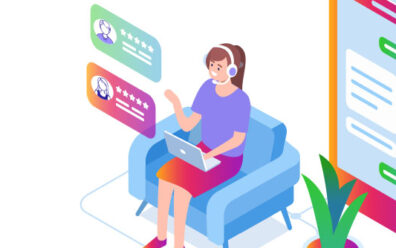Call Center Outsourcing5 minute read
5 Lessons Digital Retailers Can Learn from the In-Store Customer Experience
Far from being obsolete, the in-store customer experience has become a key part of omnichannel marketing, with plenty of lessons to offer digital retailers.

For decades, commerce has been shifting to the digital realm. Where most Americans once drove to the local mall to make their next big purchase, today, they generally prefer to shop from the comfort of their own homes. And, every year, shattered records for online sales bear witness to this trend.
Yet despite this dramatic shift, the traditional in-store customer experience is hardly dead. Not only is it alive and well—Walmart, Costco and CVS all easily outranked Amazon.com on the National Retail Federation’s list of 2017’s Top Retailers, for instance—it is in many ways more important than ever.
As part of an omnichannel marketing plan—a comprehensive, cross-channel strategy that uses all available means of modern communications to engage with customers—the in-store customer experience still has much to offer. Indeed, the savviest of today’s retail leaders are not only embracing it as an essential and unique part of their sales plan, they’re also applying hard-won lessons from decades of in-store retailing to create the best possible overall experience for their customers.

5 Lessons to Be Learned from the In-Store Customer Experience
Some of the lessons of the in-store customer experience are simple—an intuitive, easy-to-understand design, for example, is just as important to the layout of a website as it is to a brick-and-mortar store. But some lessons are a little more elusive—and all the more important for that.
Lesson #1: The Value of Human Engagement
One of the defining aspects of online shopping is the lack of a personal touchpoint—a major reason why the in-store customer experience remains a priority for successful companies, such as Apple and Tesla. Especially before making a major purchase, the ability to talk with a rep and get a more in-depth understanding of the product is a key driver of sales performance and customer satisfaction.
The modern contact center seeks to recreate this customer engagement with the sophisticated use of instant communications technologies, including SMS messaging, live chat and even tweeting. The idea is to bring the most beneficial elements of the in-store customer experience to the digital arena to improve the process for the customer (and, ultimately, the satisfaction, too).
Lesson #2: The Allure of Exclusive Access
Exclusive sales or promotions available only to an elite few—those who have joined a rewards club, or signed up for a mailing list—have long been effective methods for in-store retailing. Traditionally delivered via direct mail promotions or even phone calls, today’s exclusive offers, sent via email or teased on social media, have proven to be an even bigger driver of online sales.
Exclusive sales, bonus bucks, elite traveler status—the form will vary depending on the industry and type of customer. And a forward-thinking, omnichannel marketing plan will deliver this strategic element via an equally diverse array of communications technologies, including tools such as promotional emails, exclusive announcements for social media followers, and online referrals.

Lesson #3: The Power of Personalization
Linked closely with the idea of exclusive access is personalization, or developing and documenting unique relationships with each customer, and then giving that relationship value. A staple of the more traditional, in-store customer experience where clerks may know customers by name, and even anticipate their needs, personalization cultivates brand loyalty and satisfaction via ease of use.
Today, online retail has built out this essential component of omnichannel marketing with sophisticated methods of data tracking and advanced analytics. The idea is to track shopping patterns, history and preferences, then use that data to make sure your best offers meat the right customers—whether via email, SMS or a Facebook ad—at the right time. (In this sense, personalization is akin to targeting, allowing for a more specific use of resources.)
“The idea is to track shopping patterns, history and preferences, then use that data to make sure your best offers meat the right customers—whether via email, SMS or a Facebook ad—at the right time.” Click To Tweet
Lesson #4: The Need for Data & Analytics
Of course, personalization wouldn’t be possible without advanced analytics. Originally, this information was developed in the brick-and-mortar world, where savvier retailers analyzed customer preferences, shopping patterns and traffic routes to determine ordering, inventory, distribution and even store layout. Today, analytics is an even more natural fit for digital sales, with its almost limitless capacity to track, compile and analyze every interaction.
But analytics offers more than the power to personalize consumer content. It also improves operational efficiencies by providing the data to more effectively schedule agents’ shifts, anticipate times of increased utilization and track metrics with the goal of making improvements. A dedicated contact center partner includes analytics at every step of the customer experience to ensure ongoing improvements and ease of feedback.

Lesson #5: Don’t Skimp on Infrastructure
Successful retailers would never accept substandard lighting, plumbing or heating in their stores. Similarly, online-focused sellers shouldn’t expect much success if their digital infrastructure doesn’t support an equally comfortable customer experience. A sluggish load time, a difficult-to-understand storefront, website security concerns—these are all valid reasons for customers to jump ship and head to competitors’ sites.
Similarly, every aspect of your customer experience should reflect high-quality hardware and software, from your live-chat platform to the servers housing your website and ecommerce data. Here again, partnering with a dedicated customer experience provider can help ensure that every aspect of your infrastructure is up to the task—updated, fully secure and ready to go.
“Partnering with a dedicated customer experience provider can help ensure that every aspect of your infrastructure is up to the task—updated, fully secure and ready to go.” Click To Tweet
Time to call in the professionals? We specialize in providing a complete omnichannel customer sales and support solution that includes these essential elements from the in-store customer experience, and much more. Contact us today to find out how we can help you deliver a superior, omnichannel customer experience.

Find out how we can help you deliver superior customer experience today.
Contact Us.
This Might Interest You...
This website uses cookies to personalize and improve your experience. Continue browsing our site if you agree to our Cookie Policy or feel free to Manage Cookies yourself.


